 A new dossier of sovereigns’ letters to Ippolita Ludovisi, powerful Princess of Piombino. Collection of HSH Prince Nicolò and HSH Princess Rita Boncompagni Ludovisi, Rome.
A new dossier of sovereigns’ letters to Ippolita Ludovisi, powerful Princess of Piombino. Collection of HSH Prince Nicolò and HSH Princess Rita Boncompagni Ludovisi, Rome.
Olimpia Ippolita Ludovisi (born in Cagliari 24 December 1663, and died in Rome 29 December 1733) was to be the last member of the Ludovisi family proper. She was the fourth of five children of Niccolò Ludovisi (1613-1664), who acquired the Principate of Piombino in 1634, and his third wife Costanza Pamphili (1627-1665, niece of Pope Innocent X). Ippolita and her siblings thus had two Popes as great-uncles; for their father’s paternal uncle was Alessandro Ludovisi (1554-1623), named as Archbishop of Bologna in 1612, Cardinal in 1616, and then as Pope Gregory XV in 1621. Yet Ippolita hardly was to know her parents. Her father Niccolò died in Sardinia just one day after her first birthday, and her mother Costanza only three months after that, in her ninth month of pregnancy with a posthumously-born (and short-lived) son.
After the death of Niccolò Ludovisi, the Principate of Piombino fell to the rule of Ippolita’s elder brother Giovanni Battista Ludovisi (born 1647), who held the title of Prince from early 1665 and reigned for almost 35 years, until his death on 24 August 1699. Yet on his death, there was no truly suitable heir. Giovanni Battista Ludovisi had a newborn son named Niccolò by his wife, the highly accomplished Anna Arduino Furnari, whom he had married in 1697. Anna ruled as regent for the infant son—who then died after a year or so, in 1699.
 Map of Piombino, with Elba. P. Mortier (1724), after Blaeu (1705)
Map of Piombino, with Elba. P. Mortier (1724), after Blaeu (1705)
Next in line to rule Piombino was Ippolita’s sole living sibling, her sister Olimpia (born 1656). But she too soon died, on 27 November 1700. In any case, Olimpia strikes one as an unlikely sovereign of this strategically important principality of the Holy Roman Empire. At the time she assumed rule of Piombino, Olimpia was known as “Suor Anna” of the Congregazione di Santa Francesca Romana a Tor de’ Specchi in Rome.
In 1681 Ippolita Ludovisi had married the Duke of Sora, Gregorio Boncompagni (7 July 1642-1 January 1707)—a union that started the Boncompagni Ludovisi dynasty, combining these two great Papal Bolognese families. Gregorio—the grandnephew of Ugo Boncompagni, later Pope Gregory XIII—had recently lost his first wife, Giustina Gallio, of the Dukes of Alvito (1644-1679). Their one child, a son born not long after their marriage in 1666, died in infancy.
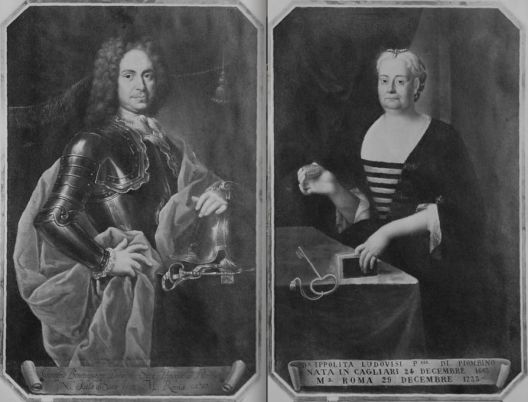 Gregorio (I) Boncompagni and his wife Ippolita Ludovisi (B+W reproductions of portraits that today hang in the Casino Aurora). By marriage compact, their descendants would bear the name Boncompagni Ludovisi. Collection of HSH Prince Nicolò and HSH Princess Rita Boncompagni Ludovisi, Rome.
Gregorio (I) Boncompagni and his wife Ippolita Ludovisi (B+W reproductions of portraits that today hang in the Casino Aurora). By marriage compact, their descendants would bear the name Boncompagni Ludovisi. Collection of HSH Prince Nicolò and HSH Princess Rita Boncompagni Ludovisi, Rome.
Ippolita for her part had been engaged to a member of the Doria family, of the Dukes of Tursi. The Boncompagni Ludovisi family archivist Giuseppe Felici, in an unpublished treatise on Gregorio Boncompagni, claims “we don’t know precisely the reason” why that marriage was called off. He does cite a significant number of love letters and even love poetry (“not blessed by the Muses”, observes Felici) from Gregorio to Ippolita. But family lore—which we will discuss in depth at another time on this blog—tells of Gregorio abducting Ippolita, the suicide of her fiancée, a curse, and even a recurring ghost. You can read a reasonably well-informed summation of the more sensational aspects of that story here (from a 1924 article on Margaret Preston Draper, an American heiress who married a sixth great-grandson of Ippolita Ludovisi).
In the event, Gregorio and Ippolita had seven children, one son (Ugo, born 1684, who died at age 2), and six daughters. We will have to discuss on another occasion how the eldest daughter, Maria Eleonora Boncompagni Ludovisi, came to marry her uncle, Antonio Boncompagni (1658-1721) in 1702. The other daughters also all married into prominent noble families: Giustiniani, Barberini, Ottoboni, Salviati, Caracciolo.
To return to our main story. Gregorio Boncompagni was invested as Prince of Piombino on 27 February 1701. But due to the tumult of the War of the Spanish Succession (1701-1714), it took almost five full years for Gregorio and Ippolita to make their solemn entrance into their Principality (on 8 February 1706). Gregorio’s first major official act seems to have been a sensible one: in a decree of 4 June 1706, he enacted that the calendar year in Piombino would henceforth commence on 1 January—not 25 March, as before.
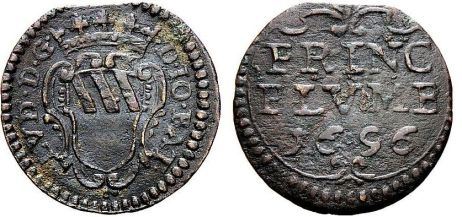 Coin (three quattrini, 1696) of Giovanni Battista Ludovisi, brother of Ippolita, and Prince of Piombino 1665-1699. The obverse shows the Ludovisi coat of arms with the legend D IO BAT LVD D G, the reverse PRINC PLVMB 1696 (i.e., Dominus Joannes Baptista Ludovisius Dei Gratia / Plumbini Princeps)
Coin (three quattrini, 1696) of Giovanni Battista Ludovisi, brother of Ippolita, and Prince of Piombino 1665-1699. The obverse shows the Ludovisi coat of arms with the legend D IO BAT LVD D G, the reverse PRINC PLVMB 1696 (i.e., Dominus Joannes Baptista Ludovisius Dei Gratia / Plumbini Princeps)
After Gregorio’s death in 1707, Ippolita ruled as Principessa of Piombino until her own demise in 1733. It would make for a long narrative to detail her energetic reign, which included everything from participation in the treaties-signing at the Congress of Utrecht (1713, in connection with the War of the Spanish Succession), to fighting pirates (endemic to the coast of southeastern Tuscany and the island of Elba, which also formed part of her Principality), to assisting at the birth of Charles Edward Stuart (= “Bonnie Prince Charlie”) at the Palazzo Muti in Rome in 1720. A matriarchy was in the making: Ippolita’s rule was followed by that of her eldest daughter Maria Eleonora Boncompagni Ludovisi, sovereign Princess of Piombino from 1734 until her death in 1745.
In one of the (numerous) letters that have recently come to light in the Casino Aurora, Louis XIV of France (the “Sun King”) on 28 March 1707 thanks the Princess of Piombino, Ippolita Ludovisi, for her well wishes on the birth of his great grandson, Louis, Duke of Brittany. The boy born at Versailles 8 January 1707, and to die just five years later, in March 1712.
In other letters dated to 1702, Queen Maria Luisa of Savoy (first wife of Philip V of Spain, and then just thirteen years old), writes to Ippolita from Barcelona and Zaragosa respectively.
As it happens, Ippolita maintained close relations with the Camarera Mayor of the Spanish court, the powerful Marie Anne de la Trémoille (who styled herself princess “des Ursins”), who acted as chief of household to the juvenile queen. And after the death of Queen Maria Luisa in 1714, Ippolita accompanied Elisabetta Farnese to Parma for her nuptials with Philip V on 25 August of that year. These relationships find close discussion in a series of (unpublished) studies by Giuseppe Felici in the Villa Aurora archive.
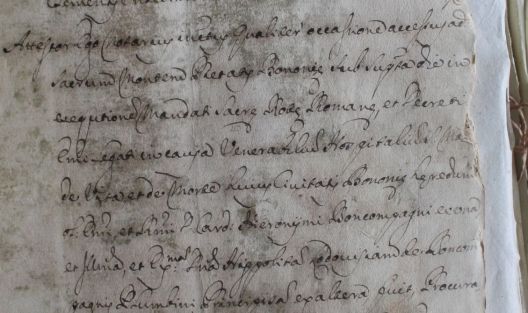 From 1706, detail of an inventory of the precious gems (“gioje”) in the collection of Ippolita Ludovisi, with (upper image) the intricately-crafted paper cover of the document. Collection of HSH Prince Nicolò and HSH Princess Rita Boncompagni Ludovisi, Rome.
From 1706, detail of an inventory of the precious gems (“gioje”) in the collection of Ippolita Ludovisi, with (upper image) the intricately-crafted paper cover of the document. Collection of HSH Prince Nicolò and HSH Princess Rita Boncompagni Ludovisi, Rome.
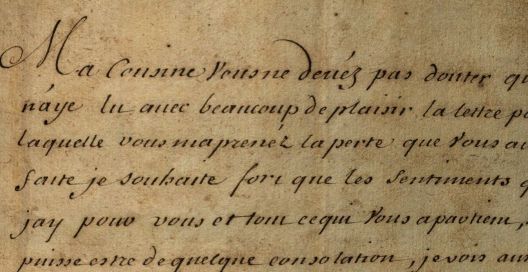

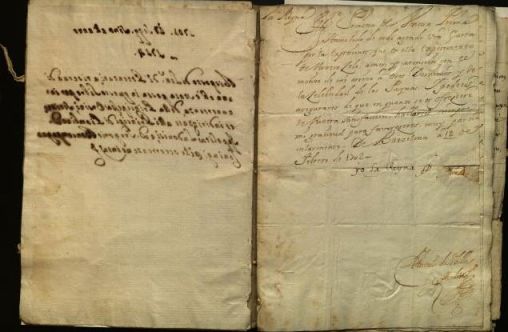

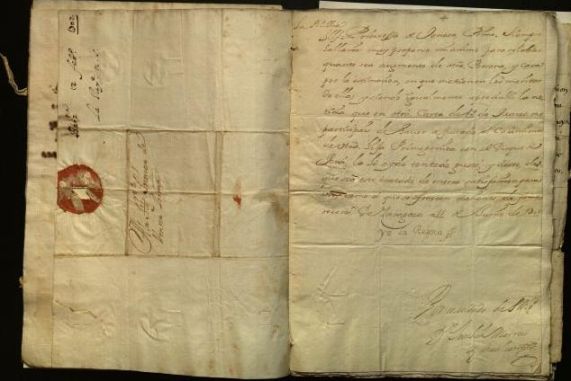

Leave a comment